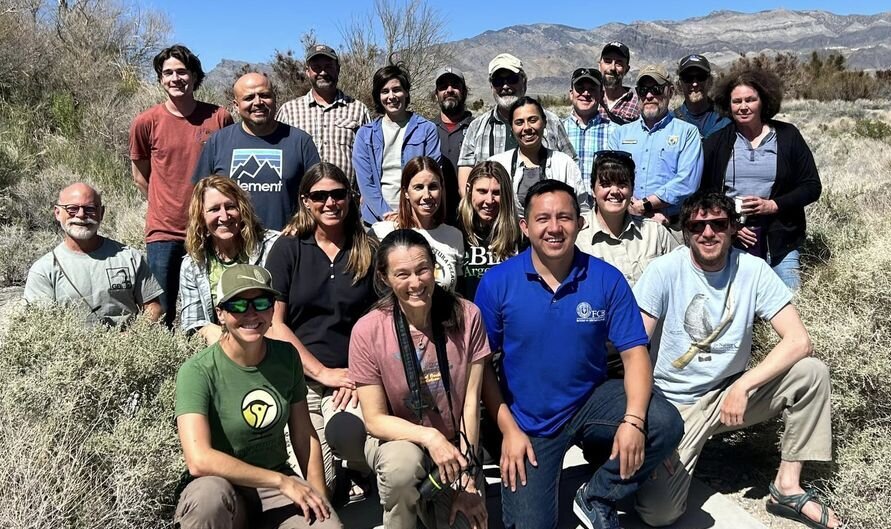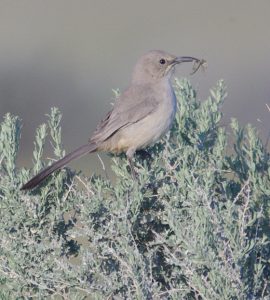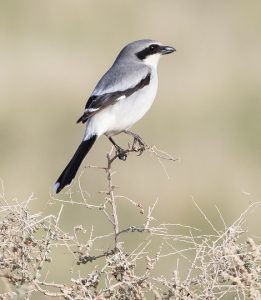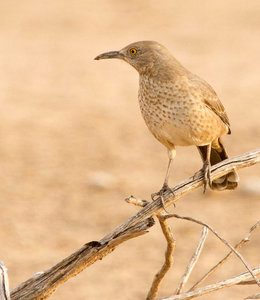Desert Thrasher Working Group

Members of the Desert Thrasher Working Group pose at the Las Vegas National Wildlife Refuge in 2023 (photo by Chrissy Kondrat).
About
The Desert Thrasher Working Group (DTWG) was formed in January 2010, following enthusiasm generated from a LeConte’s Thrasher Workshop held at the Barry M. Goldwater Range in Southwest AZ. During this workshop, concerns were raised about negative population trends in LeConte’s Thrashers, and concerns were mirrored for Bendire’s Thrashers. Loggerhead Shrikes also exhibit significant population declines, and in desert habitats are largely overlapping with these two thrasher species. All three species have shown significant population declines based on BBS data and are listed as species of conservation concern by the USFWS and Partners in Flight (PIF). PIF considers these two thrasher species among species requiring the most urgent action. Similarly, within their respective ranges, each state lists them as a Species of Greatest Conservation Need. Conservation action is essential to improve the status of these species. However, research gaps (e.g. true population size and trends, habitat needs, movement patterns, limiting factors) are significant, and mechanisms to achieve meaningful conservation measures are not well understood or defined.
The DTWG identified the need to better understand these understudied birds, with the goal of developing management recommendations to address their long-term declines. In 2015, the group facilitated the design and implementation of a research project on breeding Bendire’s Thrashers in New Mexico. The effort was expanded into Arizona in 2016 to conduct statewide surveys with the assistance of more than 50 volunteers under the support and guidance of Tucson Audubon Society and Arizona Game and Fish Department. In 2017 with funding from the Bureau of Land Management (BLM), the group collaborated to design and implement a pilot year effort to survey for Bendire’s Thrashers, LeConte’s Thrasher, and Loggerhead Shrike in Arizona, California, and Nevada. With additional BLM funding, the group expanded the study throughout Arizona, California, Nevada, New Mexico, and Utah in 2018. The results from surveys conducted in 2017 and 2018 are summarized in Ammon et al. 2020.
Since that time, the DTWG has continued to implement surveys across both species’ range in the U.S., and has expanded efforts into Sonora, Mexico. Surveys have been conducted in California annually since 2017, in Nevada surveys have been conducted annually since 2017 (except for 2019 & 2020), in Arizona 2016-2021, including some in partnership with the Department of Defense, in New Mexico in 2020, and in Sonora in 2021 and upcoming in 2024. Survey results are being used to update species distribution models, to analyze vegetation characteristics at occupied plots, and to better understand overall distribution and habitat associations of these two species across their range, including in Mexico.
Other DTWG projects currently underway also include a study to understand the dynamics of migration in Bendire’s Thrashers, preparation of additional survey protocols, and preparation of a Desert Thrasher Conservation Strategy. Results of all of these are expected in early 2024.

LeConte’s Thrasher

Loggerhead Shrike

Bendire’s Thrasher
DTWG Mission
The Desert Thrasher Working Group seeks to design, implement, and evaluate range-wide, collaborative research and monitoring efforts that will increase our knowledge and understanding of at-risk desert species to proactively inform conservation and management strategies.
Goals and Objectives
The primary objective of the current study is to estimate distribution, determine population trends over time, and to identify habitat preferences for Bendire’s Thrasher, LeConte’s Thrasher, and Loggerhead Shrike. Our long-term goal is to develop a series of Beneficial Management Practices that will inform effective conservation management strategies.
Members
Membership is open to anyone with an interest in thrasher conservation. The group consists of a diverse partnership of federal and state agencies, academics, non-governmental organizations, native Nations, and private citizens including: American Bird Conservancy, Audubon Southwest, Arizona Game and Fish Department, Barry M. Goldwater Range, Bureau of Land Management, Cabeza Prieta National Wildlife Refuge, California Central Coast Joint Venture, Center for Environmental Management Military Lands, Comisión de Ecología y Desarrollo Sustentable del Estado de Sonora, Department of Defense, Gila River Indian Community, Great Basin Bird Observatory, Lake Mead National Park, Luke Air Force Base, Maricopa Audubon, Mesa Ecological Services, Nevada Department of Wildlife, New Mexico Department of Game and Fish, New Mexico State University, Organ Pipe Cactus National Monument, Organización Vida Silvestre, Pacific Coast Conservation Alliance, Petrified Forest National Park, Pima County Department Natural Resources, Point Blue Conservation Science, Red Cliffs Desert Reserve, San Diego Natural History Museum, Salt River Pima-Maricopa Indian Community, Sonoran Audubon Society, Sonoran Joint Venture, Tucson Audubon Society, Tule Springs National Monument, Universidad Estatal De Sonora, University of Arizona, U.S. Fish and Wildlife Service, Utah Division of Wildlife Resources, and Yuma Proving Ground.
Meetings
The DTWG holds quarterly virtual meetings to discuss the status of ongoing work, strategies, and collaborate with partners, as well as holds as needed committee meetings. The group meets in person every few years. Most recently, the DTWG met at the Las Vegas National Wildlife Refuge in Nevada during April 2023.
How to Participate
To join the DTWG or to learn more about our various projects, please contact: Chrissy Kondrat (AZ), Corrie Borgman (NM), Dawn Fletcher (NV).
Resources
Desert Thrasher Conservation Strategy
Protocol
Data Sheets
Training Materials
Solar Resources
Technical Reports
- Ammon, E.M., D.M. Fletcher, L.B. Harter, C.C. Borgman, E. Duvuvuei, G. Geupel, D. Jongsomjit, E. Juarez, C.L. Kondrat, E. Masters, and R. Norvell 2020. Survey methods, habitat models, and future directions for conservation of Bendire’s and LeConte’s Thrashers: A comprehensive report of region-wide surveys in 2017-2018. GBBO Gen. Tech. Report 2019-1.Great Basin Observatory, Reno, NV.1.
- Arizona Bird Conservation Initiative and Sonoran Joint Venture. 2019. LeConte’s Thrasher (Toxostoma lecontei) Species Account. Available at https://sonoranjv.org/accounts/lecontes-thrasher.pdf.
- Blackman, S.T. and J. Diamond. 2015. Meta-population dynamics of LeConte’s Thrasher (Toxostoma lecontei): a species at risk on three southwestern military installations. Year 3 report. Wildlife Contracts Branch, Arizona Game and Fish Department.
- Desmond, M.J. and C.B. Sutton. 2017. Breeding habitat requirements and territory size of Bendire’s Thrasher (Toxostoma bendirei). Department of Fish, Wildlife and Conservation Ecology, New Mexico State University. Final Report to New Mexico Department of Game & Fish.
- Fletcher, D.M. 2009. Distribution and site selection of LeConte’s and Crissal Thrashers in the Mojave Desert: a multi-model approach (unpublished master’s thesis). University of Nevada, Las Vegas, Nevada.
- Grodsky, S.M., K.E. Tanner, and R.R. Hernandez. 2020. Desert plant response to solar energy development: trophic interactions, rare and invasive species, and management implications. California Energy Commission. Publication Number: CEC-500-2020-076.
- Hargrove, L., P. Unitt, K. Ferree, K. Clark, and L. Squires. 2019. LeConte’s Thrasher (Toxostoma lecontei) status and nest site requirements in the Coachella Valley. Report prepared for the Coachella Valley Conservation Commission. San Diego Natural History Museum, San Diego.
- Jongsomjit, D., L. Salas, J. Tietz, and G.R. Geupel. 2014. Point Blue Conservation Science, LeConte’s Thrasher abundance modeling: summary report to the Bureau of Land Management.
- Kondrat, C.L. 2022. Separation of Bendire’s and Curve-billed Thrashers: An Identification Primer. North American Birds. Vol 73, No 1.
- Kondrat-Smith, C. and S. Lowery, 2018. Movement patterns, survivorship, and home range size of LeConte’s Thrasher (Toxostoma lecontei) on the Barry M. Goldwater Range. Poster. Arizona Game and Fish Department.
- Salas, A. and M.J. Desmond. 2023. Post-fledging survival, movement patterns, and habitat associations of Bendire’s Thrashers (Toxostoma bendirei) in the Chihuahuan Desert. Avian Conservation and Ecology 18(2):2. https://doi.org/10.5751/ACE-02477-180202.
- Salas, A.J. 2021. Nest Survival and post-fledgling survival, movement, and habitat use of Bendire’s Thrasher (Toxostoma bendirei) in the Chihuahuan Desert (unpublished master’s thesis). New Mexico State University, Las Cruces, New Mexico.
- Salas, A., and M. Desmond. 2019. Bendire’s Thrasher nest and juvenile survival in relation to vegetation characteristics in the southwestern United States. Report to New Mexico Department of Game & Fish.
- Sutton, C.T.B. 2020. Breeding habitat requirements and territory size of Bendire’s Thrasher (Toxostoma bendirei) in the southwestern U.S. Unpublished master’s thesis. New Mexico State University, Las Cruces, New Mexico.
Publications
- Grodsky, S.M. and R.R. Hernandez. 2020. Reduced ecosystem services of desert plants from ground-mounted solar energy development. Nat Sustain 3, 1036–1043.
- Sheppard, J.M. 1970. A study of the LeConte’s Thrasher. California Birds 1:85–95.
- Sheppard, J.M. 2018. The Biology of a Desert Apparition: LeConte’s Thrasher (Toxostoma lecontei). Studies of Western Birds No. 2. Western Field Ornithologists.

